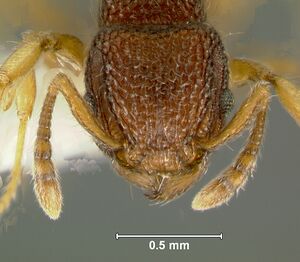Tetramorium khnum
| Tetramorium khnum | |
|---|---|

| |
| Scientific classification | |
| Kingdom: | Animalia |
| Phylum: | Arthropoda |
| Class: | Insecta |
| Order: | Hymenoptera |
| Family: | Formicidae |
| Subfamily: | Myrmicinae |
| Tribe: | Crematogastrini |
| Genus: | Tetramorium |
| Species: | T. khnum |
| Binomial name | |
| Tetramorium khnum Bolton, 1977 | |
Nothing is known about the biology of Tetramorium khnum.
Identification
Bolton (1977) - All specimens originate from Dumaguete, the type-locality. Two other species of this group occur in the Philippines besides khnum. These are Tetramorium chapmani, which is easily distinguished as the first gastral tergite is strongly sculptured basally, and Tetramorium zypidum in which the petiole and postpetiole are almost or entirely unsculptured.
Distribution
Latitudinal Distribution Pattern
Latitudinal Range: 9.316667° to 6.733167°.
| North Temperate |
North Subtropical |
Tropical | South Subtropical |
South Temperate |
- Source: AntMaps
Distribution based on Regional Taxon Lists
Indo-Australian Region: Philippines (type locality).
Palaearctic Region: China.
Distribution based on AntMaps
Distribution based on AntWeb specimens
Check data from AntWeb
Countries Occupied
| Number of countries occupied by this species based on AntWiki Regional Taxon Lists. In general, fewer countries occupied indicates a narrower range, while more countries indicates a more widespread species. |

|
Estimated Abundance
| Relative abundance based on number of AntMaps records per species (this species within the purple bar). Fewer records (to the left) indicates a less abundant/encountered species while more records (to the right) indicates more abundant/encountered species. |

|
Biology
Castes
   
| |
| . | Owned by Museum of Comparative Zoology. |
Nomenclature
The following information is derived from Barry Bolton's Online Catalogue of the Ants of the World.
- khnum. Tetramorium khnum Bolton, 1977: 122, fig. 52 (w.) PHILIPPINES.
Unless otherwise noted the text for the remainder of this section is reported from the publication that includes the original description.
Description
Worker
Holotype. TL 3.1, HL 0.74, HW 0.70, CI 94, SL 0.48, SI 69, PW 0.54, AL 0.84.
Mandibles striate; anterior clypeal margin entire. Frontal carinae long and strongly developed, reaching well beyond the posterior margins of the eyes, almost to the occipital corners. Antennal scrobes long and broad, moderately deep, conspicuous, their reticulate-punctulate sculpture contrasting strongly with the rugosity of the remainder of the head. Eyes of moderate size, maximum diameter c. 0.16. Propodeal spines acute, narrow and relatively short, only as long as or slightly longer than the broad, somewhat upcurved metapleural lobes. Petiole in profile with the dorsal length of the node greater than the height of its tergal portion, the anterior face slightly higher than the posterior (Fig. 52). Node in dorsal view broader than long. Dorsum of head covered by a coarse dense, close rugoreticulum, the meshes of which are small and appear reticulate-foveolate in places. Dorsal surfaces of alitrunk, petiole and postpetiole similarly sculptured; gaster unsculptured. All dorsal surfaces of head and body with numerous fine hairs of varying length. Leading edge of antennal sea pes with numerous short hairs and also with a spaced row of longer, stouter hairs which are subequal in length to the maximum width of the scape. Dorsal (outer) surface of hind tibiae with outstanding fine, erect or suberect hairs. Colour reddish brown, the gaster lighter in shade than the alitrunk, and with the legs yellowish.
Paratypes. As holotype but range of measurements TL 2.8-3.2, HL 0.70-0.76, HW 0.66-0.74, CI 92-97, SL 0.46-0.50, PW 0.52-0.58, AL 0.74-0.86 (16 measured). Maximum diameter of eye c. 0.14-0.16.
Type Material
Holotype worker, Philippines: Dumaguete, 23.iv.l925 (J. W. Chapman) (Museum of Comparative Zoology). Paratypes. 10 workers with same data as holotype and 13 workers with same locality data but 'Camp', 6.iv.1931, no. I (J. W. Chapman) (MCZC; The Natural History Museum; Naturhistorisches Museum, Basel).
References
- Bolton, B. 1977. The ant tribe Tetramoriini (Hymenoptera: Formicidae). The genus Tetramorium Mayr in the Oriental and Indo-Australian regions, and in Australia. Bulletin of the British Museum (Natural History). Entomology. 36:67-151. (page 122, fig. 52 worker described)
- General, D.E.M., Buenavente, P.A.C., Rodriguez, L.J.V. 2020. A preliminary survey of nocturnal ants, with novel modifications for collecting nocturnal arboreal ants. Halteres 11: 1-12 (doi:10.5281/ZENODO.3707151).
- Liu, C., Fischer, G., Hita Garcia, F., Yamane, S., Liu, Q., Peng, Y.Q., Economo, E.P., Guénard, B., Pierce, N.E. 2020. Ants of the Hengduan Mountains: a new altitudinal survey and updated checklist for Yunnan Province highlight an understudied insect biodiversity hotspot. ZooKeys 978, 1–171 (doi:10.3897/zookeys.978.55767).
References based on Global Ant Biodiversity Informatics
- Bolton B. 1977. The ant tribe Tetramoriini (Hymenoptera: Formicidae). The genus Tetramorium Mayr in the Oriental and Indo-Australian regions, and in Australia. Bulletin of the British Museum (Natural History). Entomology 36:67-151.
- Bolton, B. "The ant tribe Tetramoriini (Hymenoptera: Formicinae. The genus Tetramorium Mayr in the Oriental and Indo-Australian regions and in Australia." Bulletin of the British Museum (National History): Entomology series 36, no. 2 (1977): 68-151.
- Chen Y., C. W. Luo, H. W. Li, Y. J. Liu, H. F. Zheng, and F. C. Yang. 2013. Investigation of ant species and distribution on Wuliang Mountain. Journal of Henan Agricultural Sciences 42(5): 118-122.
- Fontanilla A. M., A. Nakamura, Z. Xu, M. Cao, R. L. Kitching, Y. Tang, and C. J. Burwell. 2019. Taxonomic and functional ant diversity along tropical, subtropical, and subalpine elevational transects in southwest China. Insects 10, 128; doi:10.3390/insects10050128
- Guénard B., and R. R. Dunn. 2012. A checklist of the ants of China. Zootaxa 3558: 1-77.
- Song Y., Z. Xu, C. Li, N. Zhang, L. Zhang, H. Jiang, and F. Mo. 2013. An Analysis on the Ant Fauna of the Nangun river Nature Reserve in Yunnan, China. Forest Research 26(6): 773-780.
- Xu Z. 1999. [An analysis on the ant fauna of the tropical rain forest in Xishuangbanna of China.] Zoological Research 20: 379-384.

